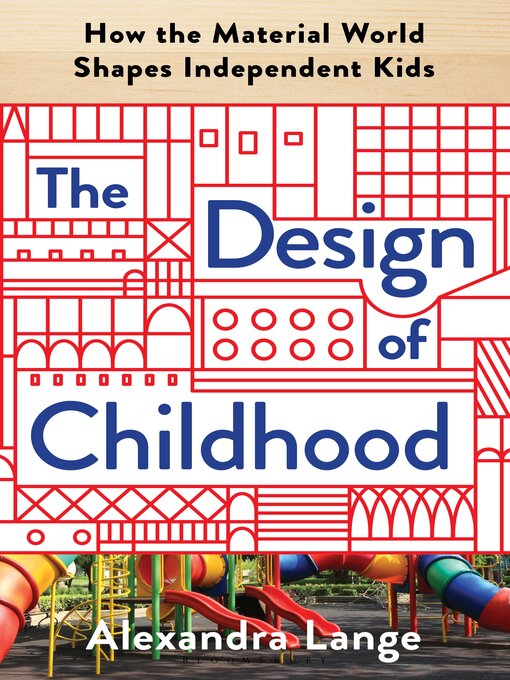Parents obsess over their children's playdates, kindergarten curriculum, and every bump and bruise, but the toys, classrooms, playgrounds, and neighborhoods little ones engage with are just as important. These objects and spaces encode decades, even centuries of changing ideas about what makes for good child-rearing—and what does not. Do you choose wooden toys, or plastic, or, increasingly, digital? What do youngsters lose when seesaws are deemed too dangerous and slides are designed primarily for safety? How can the built environment help children cultivate self-reliance? In these debates, parents, educators, and kids themselves are often caught in the middle.
Now, prominent design critic Alexandra Lange reveals the surprising histories behind the human-made elements of our children's pint-size landscape. Her fascinating investigation shows how the seemingly innocuous universe of stuff affects kids' behavior, values, and health, often in subtle ways. And she reveals how years of decisions by toymakers, architects, and urban planners have helped—and hindered—American youngsters' journeys toward independence. Seen through Lange's eyes, everything from the sandbox to the street becomes vibrant with buried meaning. The Design of Childhood will change the way you view your children's world—and your own.
-
Creators
-
Publisher
-
Release date
June 12, 2018 -
Formats
-
Kindle Book
-
OverDrive Read
- ISBN: 9781632866370
- File size: 48302 KB
-
EPUB ebook
- ISBN: 9781632866370
- File size: 49643 KB
-
-
Languages
- English
-
Reviews
-
Publisher's Weekly
March 5, 2018
Architectural historian Lange (Writing About Architecture) skillfully explores how the design of children’s toys and built environments reflects evolving philosophies of child-rearing and development. Lange begins by discussing how children learn through building toys like standarized wooden “unit blocks,” introduced in the early 20th century; their more adaptable successor, Lego; and today’s digital alternative, Minecraft. The construction of high chairs, school desks, and playgrounds, meanwhile, reveals shifting value judgments by parents and educators about the balance between participation, freedom, and safety. Lange contrasts the suburban model of the home as primary play space with modern city designs that aim to allow children to play freely near their homes. When money is not made available to update spaces in lower-income areas, she warns, those communities can suffer. The book also tracks the design of classrooms and schools over the course of American history, from the earliest one-room schoolhouses; through the fixed-desk rows of the late 19th century, when reformers began introducing compulsory education; to today’s open-plan layouts. Never attempting the role of parenting guru or educator, Lange is not prescriptive, but does powerfully remind readers of the importance of constructing spaces that make all people, including children, feel both welcomed and independent. B&w photos. Agenct: Phyillis Wender, Gersh Agency. -
Kirkus
April 1, 2018
An informative road map for those who want to maximize their children's material environment.When architecture critic Lange (The Dot-Com City: Silicon Valley Urbanism, 2014, etc.) had her first child, she "came to see each successive stage of childhood development as an opportunity for encounters with larger and more complex environments." Her approach is primarily historical and design-focused as she explores five specific topics that make up the "designed-for-childhood environment": blocks, house, school, playground, and city. Corrugated cardboard boxes appeared in the 1870s, and children quickly saw their appeal as playthings. Wooden beads and blocks gained popularity around 1900. Blocks designed by Friedrich Froebel, the inventor of kindergarten, became popular when Milton Bradley began manufacturing them in the 1870s. Lange then traces the development and sophistication of blocks from the Danish LEGO (leg godt or "play well") to "Minecraft" to Zoob, each crucial to stimulating children's imaginations. Next up is house; as the author writes, children "need furnishings couched to their frames but also to their abilities." The high chair dawned in the 1830s, followed by kid-size dishes. In 1929, Parents magazine featured the "Whole-Family House." Lange teaches us about Maria Montessori, the "magic of the storage wall," and the significance of Peter Opsvik's multipurpose Tripp Trapp chair. School focuses on how "pedagogy and architecture go hand in hand." The first spaces in America called "play grounds" were created in Boston in 1885 out of piles of sand, and the first jungle gym was installed in Winnetka, Illinois, in 1920. Lange argues that "segregating children's play from the flow of urban life creates its own problems." She hands out A ratings to cities (Rotterdam, Oslo, Seattle) who are redesigning city spaces in terms of children's welfare. Disneyland gets an A-plus for its exemplary "child-friendly outdoor environment."Parents and educators will discover a wealth of information to inspire and help "make childhood a better place."COPYRIGHT(2018) Kirkus Reviews, ALL RIGHTS RESERVED.
-
Formats
- Kindle Book
- OverDrive Read
- EPUB ebook
subjects
Languages
- English
Loading
Why is availability limited?
×Availability can change throughout the month based on the library's budget. You can still place a hold on the title, and your hold will be automatically filled as soon as the title is available again.
The Kindle Book format for this title is not supported on:
×Read-along ebook
×The OverDrive Read format of this ebook has professional narration that plays while you read in your browser. Learn more here.


